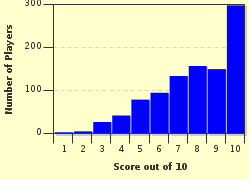Quiz Answer Key and Fun Facts
1. Saint Lucia is part of the archipelago called the Lesser Antilles, on the eastern edge of the Caribbean Sea. Which of the following is NOT one of its nearest neighbours?
2. In 1660 the French took control of the island they named Sainte-Lucie. After whom is it thought to have been named?
3. As well as the main island, with an area of 620 sq km (385 sq mi), there are another 16 named islands in Saint Lucia. Which of these was probably named after the local fauna?
4. What kind of terrain will you find on Saint Lucia?
5. Please 'give me' the name of the peak which forms the highest point on the island of Saint Lucia.
6. Saint Lucia claims to have "the world's only drive-in volcano". By what pungent name do locals refer to it?
7. What is the climate of Saint Lucia?
8. Saint Lucia is to the east of the main hurricane belt, but it has suffered severe hurricane damage at times. What was the name of the bad boy that devastated agriculture and took nine lives on the island in 1980?
9. Saint Lucia is divided into local government regions formerly called quarters. How many quarters are there on the island of Saint Lucia?
10. By 2007, 177 species of birds had been sighted on Saint Lucia. Of these, seven are considered endemic (native), 107 are accidental (rarely sighted, and not thought to live in the area), six are members of globally threatened species, and one species was introduced by human activity. Which of these birds was introduced by humans?
Source: Author
looney_tunes
This quiz was reviewed by FunTrivia editor
Pagiedamon before going online.
Any errors found in FunTrivia content are routinely corrected through our feedback system.

